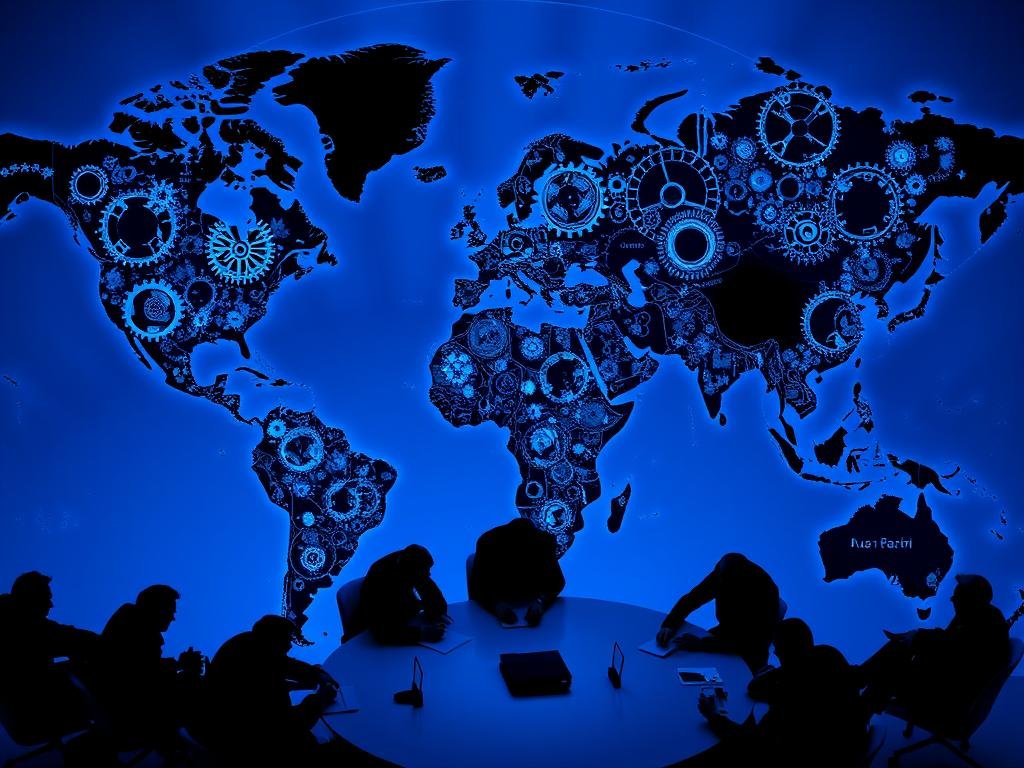The Dark Side of AI. Did you know a big part of deepfake videos online are used to spread lies or harm people’s reputations? Artificial Intelligence (AI) has made huge strides, but it also brings risks.
Deepfakes can look and sound just like real people, causing big problems like financial losses and damage to reputation. As AI keeps getting better, we really need rules to help avoid these dangers.
The misuse of AI can cause serious harm. It’s very important to know the risks of AI and what’s being done to fix them.
Key Takeaways
- The misuse of AI can lead to significant financial and reputational losses.
- Deepfakes are a major concern due to their ability to spread false information.
- Regulation is necessary to mitigate the risks associated with AI.
- Understanding AI risks is key to creating effective solutions.
- The growth of AI means we must always check its risks and benefits.
Understanding the Concept of AI
AI is not just a dream of the future; it’s part of your daily life. You see it in virtual assistants and data analysis tools. Technology keeps making AI more common.
What is Artificial Intelligence?
Artificial Intelligence means making computers do things that humans do, like seeing, talking, and making decisions. AI uses special algorithms to learn from data and get better over time.
AI is used in many ways, from simple chatbots to systems that can drive cars or find diseases. The goal is to make machines think and act like us, but faster and more accurately.
Types of AI Technologies
There are different AI technologies for different tasks. Narrow or Weak AI does one thing, like recognizing faces or searching the internet. General or Strong AI wants to do anything a human can.
AI is also divided by how it works. Machine Learning (ML) lets systems learn from data. Deep Learning (DL) is a part of ML that uses neural networks to find complex patterns.
The Evolution of AI
AI has come a long way, from simple systems to today’s deep learning models. Big datasets and powerful computers have helped AI grow.
As AI gets better, we must think about its ethics and downsides. We’ll talk more about these issues as we explore AI’s impact on society.
The Rise of Deepfakes
Deepfakes are a big deal in today’s world. They show the dangers of AI and the need for better security. It’s important to understand their impact.
Defining Deepfakes
Deepfakes are advanced tricks that use AI to make fake videos or photos. They can make it seem like someone is doing something they didn’t do. This technology is getting better at spreading lies and fake news.
The term ‘deepfake’ comes from a Reddit user who started sharing these fake videos. Now, making and sharing deepfakes is a big problem for everyone.
The Creation Process
Making deepfakes takes a lot of work and powerful computers. First, a big collection of pictures or videos of the person is gathered. Then, a deep learning model is trained to create a fake version of them.
Deepfakes are good at looking and sounding real. This makes it hard to tell what’s real and what’s not. It’s a constant battle between those who make deepfakes and those who try to spot them.
“The technology behind deepfakes is rapidly advancing, making it increasingly difficult to distinguish between real and fake content.”
Legal Implications
The laws about deepfakes are changing fast. They deal with privacy, security, and trust in media. Governments are trying to figure out how to handle these issues.
Some big legal issues include:
- Privacy problems when someone’s image is used without permission.
- Chances of scams and financial fraud.
- Effects on elections and politics from fake videos.
As deepfakes get better, laws need to keep up. This is to fight the dangers of AI and the security worries it brings.
Misinformation and AI
AI-generated content makes it hard to tell what’s real and what’s not. This has led to a lot of false information. You might see fake news every day, through different media.
The Spread of False Information
AI can make content that looks real, making it easier for false info to spread. This includes simple texts and complex deepfakes that look real. It’s hard to know if what you read is true.
Social media platforms help spread this false info. They use algorithms that focus on getting more views, not on being accurate. For more on AI in content creation, check out Digital Vista Online.
AI’s Role in Content Creation
AI can make content that looks real, changing how we share info. While it can be useful, it also has risks. AI can be used to spread false info, affecting opinions and politics.
The Dark Side of AI is growing. Forbes says deepfakes and disinformation could cost billions.
Case Studies of Misinformation
There are many examples of AI spreading false info. For example, deepfakes have made fake videos of famous people. These cases show how AI can confuse and distrust people.
- Deepfakes in politics
- AI-made news articles with false info
- Social media bots spreading lies
Looking at these examples helps us understand AI, misinformation, and their effects on society.
Psychological Impact on Society
AI-generated content is changing how we trust information. As AI gets smarter, the risk of deepfakes and misinformation grows. You see AI content everywhere, so knowing its effects is key.
Trust Issues
Deepfakes are easy to make and share, making us doubt digital media. A report by Bruegel warns of AI’s danger to trust in society.
“The ability to manipulate people’s perceptions and beliefs through AI-generated content is a significant threat to democratic processes and social cohesion.”
This loss of trust can harm us in many ways. It can sway public opinion and weaken institutions. So, it’s important to be careful and question what we see online.
Desensitization
Seeing too many deepfakes can make us less able to tell truth from lie. This can change how we see the world and interact with others.

As AI content spreads, we need ways to spot and fight its bad effects. Learning and being aware are our best defenses against AI’s harm.
Changes in Communication
AI is also changing how we talk to each other. Misinformation can lead to misunderstandings and fights. A study shows we need to understand these changes well.
| Impact | Description | Potential Consequences |
|---|---|---|
| Trust Erosion | Distrust in digital media due to deepfakes and misinformation | Manipulation of public opinion, undermining of institutions |
| Desensitization | Increased difficulty in distinguishing fact from fiction | Altered perception of reality, changes in social interactions |
| Communication Changes | Spread of misinformation affecting communication patterns | Misunderstandings, conflict, and social unrest |
Knowing the risks of AI is the first step to fixing them. By being informed and questioning what we see, we can help make the digital world safer and more trustworthy.
The Role of Social Media
Social media plays a big role in spreading deepfakes and misinformation. You’ve probably seen how fast news spreads on sites like Facebook, Twitter, and Instagram.
These platforms shape public opinion and change how we think. But, they also spread fake content, which is a big worry.
Amplification of Deepfakes
Deepfakes can spread fast on social media. One post can be shared thousands of times in just hours, reaching many people.
Algorithms and Misinformation
Algorithms on social media platforms help spread false information. They focus on content that gets a lot of engagement, even if it’s wrong.
You might have seen how sensational or provocative content gets more attention.
Policies from Major Platforms
Big social media sites are trying to fight deepfakes and misinformation. They’ve started to make rules to help.
| Platform | Policy | Status |
|---|---|---|
| Removing deepfakes that could cause harm | Implemented | |
| Labeling manipulated media | In Progress | |
| Reducing the distribution of misinformation | Implemented |
These steps are important to fight the bad effects of AI on social media.
The Need for Regulation
AI technologies are advancing fast, leading to a global debate on regulation. As AI becomes more common in our lives, worries about misuse grow. This includes AI security concerns and AI privacy risks.
Current Regulatory Landscape
The rules for AI are changing. Countries and groups are looking at new ways to manage AI. Some have set rules for AI’s use, while others are figuring out theirs.
Looking at current laws, we see a mix of rules. These rules differ a lot from place to place. Here’s a quick look at some:
| Region | Regulatory Approach | Key Features |
|---|---|---|
| European Union | Comprehensive AI Regulation | Focus on being open, accountable, and having human checks |
| United States | Sectoral Approach | Rules change by industry, with a focus on federal rules |
| Asia-Pacific | Diverse National Approaches | Each country has its own rules, from strict to loose |
Proposals for Future Regulations
As AI grows, we need better rules. Ideas for new rules include:
- Creating global AI standards
- Setting stricter rules for AI openness and responsibility
- Working together internationally to handle AI issues
These ideas aim to support innovation while protecting against AI risks.

The Balance Between Innovation and Safety
Regulating AI is tricky. We need to encourage innovation but also keep things safe. Too strict rules might slow down AI progress, while not enough could lead to misuse.
To find the right balance, regulators must talk with AI creators, users, and others. This way, they can make rules that work well and keep up with AI’s fast changes.
Ethical Considerations
Exploring AI’s complexities means looking at its ethical sides. The Dark Side of AI is a growing worry. We must tackle these risks early on.
Responsibilities of AI Creators
AI makers must think about the ethics of their work. They should aim for AI that’s clear, explainable, and fair. AI’s development is both a tech and an ethical challenge.
For example, AI in self-driving cars must follow human ethics. This ensures their decisions are right.
| Ethical Consideration | Description | Impact |
|---|---|---|
| Transparency | AI decision-making processes should be clear and understandable. | Builds trust in AI systems. |
| Fairness | AI systems should not perpetuate or amplify existing biases. | Ensures equitable treatment of all users. |
| Accountability | Developers should be held accountable for AI system failures. | Promotes responsible AI development. |
Ethical Dilemmas in AI Usage
AI raises ethical questions, like data privacy and surveillance. You might face choices where AI’s benefits weigh against privacy risks. For instance, AI surveillance tools boost security but may invade privacy.
Balancing these interests is a big challenge. It needs careful thought on AI use and safeguards to avoid harm.
Public Awareness and Education
Teaching people about AI’s ethics is key. Knowing AI’s risks and benefits helps make better choices. Educational efforts can clear up AI’s mysteries and its impact.
Also, public campaigns can stress the need for ethical AI. They push for practices that reduce Artificial Intelligence risks.
Technology for Transparency
The need for transparency in AI is growing. AI-generated content is getting harder to tell from real stuff. This makes it tough to know what’s true and what’s not.
New technologies are being made to solve these problems. These tools are key to keeping information honest in our digital world.
Tools to Identify Deepfakes
Deepfake detection tools are being created to spot AI-made content. They look for audio and video clues to see if something is real or fake.
For example, scientists have made algorithms to find deepfakes by checking audio and video together. Detection accuracy is getting better thanks to machine learning.
| Detection Method | Description | Accuracy |
|---|---|---|
| Audio-Video Sync Analysis | Examines synchronization between audio and video | 85% |
| Facial Recognition Analysis | Analyzes facial expressions and movements | 90% |
Innovations in Fact-Checking
New fact-checking tools are important to fight fake news. Advanced algorithms and AI tools are being made to check facts fast.
Automated fact-checking systems can scan lots of data to find false info. They’re being added to social media to stop fake news from spreading.
The Role of Blockchain
Blockchain tech is being looked at to make AI more transparent. It creates a permanent record of data, keeping information safe and true.
Blockchain’s decentralized nature makes it hard to change data without being caught. This helps keep trust in AI content.

In summary, tools like deepfake detectors, fact-checkers, and blockchain are essential for AI transparency. As these technologies get better, they’ll help lessen AI’s negative effects.
Future Risks and Threats
As AI grows, new risks and threats will affect your life. AI’s increasing complexity brings risks, mainly in cybersecurity and privacy.
AI in Cybersecurity
AI can be both a blessing and a curse in cybersecurity. It can improve security by spotting and fighting threats better. But, it can also help bad actors launch more advanced attacks. For example, AI-powered phishing scams can be very convincing and hard to spot.
The field of AI in cybersecurity is changing fast. A report says AI can help fight cyber threats by speeding up responses and lowering data breach risks https://builtin.com/artificial-intelligence/risks-of-artificial-intelligence. But, this also means AI security concerns are growing.
| AI Application | Cybersecurity Benefit | Potential Risk |
|---|---|---|
| Threat Detection | Enhanced detection capabilities | Potential for false positives |
| Incident Response | Faster response times | Risk of automated attacks |
Impacts on Privacy
AI’s integration into systems raises big privacy worries. AI can handle lots of personal data without asking users first. This can lead to misuse, surveillance, and less privacy.
“The increasing use of AI in data processing poses significant risks to individual privacy, as it can facilitate mass surveillance and data exploitation.”
Be careful about the data you share and know how AI uses it. It’s important to have clear data use policies and strong privacy laws to protect your privacy.
Emerging Trends to Watch
There are new AI trends to watch out for. These include better deepfakes, more AI in self-driving systems, and AI in spreading false information.
To avoid these risks, keep up with AI news and its uses. Knowing the dangers and taking steps to protect yourself can help you deal with AI threats.
International Perspectives
It’s important to understand how other countries handle AI to create global standards. AI’s growth affects everyone, making it key to work together. This helps manage risks like AI privacy issues.
How Other Countries Approach AI Regulation
Each country has its own way of regulating AI, based on its culture, economy, and politics. For example, the European Union has the GDPR, which covers AI and data protection. In contrast, the United States has a more piecemeal approach, with different rules for different AI areas.
The Dark Side of AI, like deepfakes and fake news, has led some countries to tighten their rules. China, for instance, has strict rules on deepfakes, requiring permission before they can be shared.
| Country | Approach to AI Regulation | Key Features |
|---|---|---|
| European Union | Comprehensive Regulation | GDPR, AI-specific proposals |
| United States | Sectoral Approach | Federal and state regulations |
| China | Strict Control | Regulations on deepfakes, AI ethics guidelines |
Global Standards and Agreements
Creating global standards and agreements is vital for consistent AI rules worldwide. Groups like the United Nations and OECD are working on common AI guidelines.
These standards aim to tackle AI’s challenges, like worsening social gaps and new risks. A unified framework helps countries work together on issues like AI privacy and its negative effects.

Cross-Border Implications
AI’s global reach makes regulation across borders a big challenge. Regulators must protect their people while also supporting international cooperation and trade.
To succeed, governments, industries, and civil groups must collaborate. Together, they can create frameworks that handle AI’s global nature while respecting different contexts.
Solutions to Combat Misinformation
The fight against misinformation needs education, technology, and community efforts. It’s key to find and use effective ways to fight it.
Education and Awareness Campaigns
Teaching people how to spot fake news is vital. By learning to verify sources, we can all make better choices. Awareness campaigns can reach us through social media, schools, and community centers.
Media literacy programs in schools can teach kids to think critically. Public campaigns can also warn about misinformation and teach how to spot it.
Collaborations Among Tech Companies
Tech companies are key in sharing information. Working together, they can create tools to fight fake news. For example, AI can quickly check if information is true.
They can also agree on standards for labeling misinformation. This makes the online world more reliable.
Community Initiatives and Involvement
Local efforts are important in fighting misinformation. Leaders and groups can teach media literacy and warn about fake news dangers.
Community projects can also spread true information. This helps fight the spread of false news.
| Strategy | Description | Impact |
|---|---|---|
| Education and Awareness | Educating the public on media literacy and the dangers of misinformation | Empowers individuals to make informed decisions |
| Tech Collaborations | Developing tools and technologies to identify and mitigate misinformation | Enhances the accuracy of online information |
| Community Initiatives | Promoting media literacy and accurate information at the local level | Counters the spread of misinformation in communities |
By using these strategies together, we can fight misinformation well. This makes our public more informed and critical thinkers.
The Path Forward
AI is growing, and we must think about its negative sides and dangers. It’s important to find a balance between new ideas and rules. Experts say this balance is key to using AI’s good sides while avoiding its bad ones.
Regulatory Frameworks
We need good rules to handle AI’s dangers. These rules should make AI development and use clear and fair.
Trust in AI
People need to trust AI to use it more. We can build this trust by making AI safe and secure. Also, teaching the public about AI is important.
Future Development
The future of AI is complex. We must face AI’s dangers while encouraging new ideas. This way, we can make AI’s benefits real and create a better future.
FAQ
What is the dark side of AI?
The dark side of AI includes the negative effects and risks it poses. This includes deepfakes, misinformation, and harm to individuals and society.
What are deepfakes and how are they created?
Deepfakes are AI-made content like videos or audio that aim to deceive. They use advanced AI and machine learning to create.
How does AI contribute to the spread of misinformation?
AI helps spread false information quickly through social media. It does this by generating and sharing false content at a large scale.
What are the psychological impacts of deepfakes and misinformation on society?
Deepfakes and misinformation can erode trust and change how we communicate. They can also make us less sensitive to false information.
What is the role of social media in the dissemination of deepfakes and misinformation?
Social media plays a big part in spreading deepfakes and misinformation. It does this by making them reach more people through algorithms and other means.
Why is regulation necessary to address the risks associated with AI?
Regulation is key to handle AI risks like deepfakes and misinformation. It helps ensure AI’s benefits while reducing its negative effects.
What are the ethical considerations associated with AI development and usage?
Ethical issues in AI include the responsibility of creators and the dilemmas in using AI. It’s also important to educate the public about AI’s ethics.
How can technologies promote transparency in AI?
Tools to spot deepfakes, new fact-checking methods, and blockchain can help. They make it easier to check if AI content is real.
What are the future risks and threats associated with AI?
Future AI risks include its use in cybersecurity and privacy impacts. New trends may also bring new challenges and dangers.
How can misinformation be combated?
Fighting misinformation requires education and awareness campaigns. Tech companies and communities must work together to stop it.
What is the path forward for AI development?
The future of AI involves balancing innovation with regulation. It’s also about building trust in AI and using it responsibly.
What are the international perspectives on AI regulation?
Views on AI regulation vary globally. Countries have different approaches, and there’s a push for global standards to handle international issues.
What are the AI security concerns and AI privacy risks?
AI security and privacy risks are big concerns. AI systems can be hacked, putting sensitive data and people at risk.
How can AI dangers be mitigated?
To lessen AI dangers, we need strong regulations and transparency. Public education is also key to understanding AI’s risks.
What are the negative impacts of AI on society?
AI’s negative effects include job loss and worsening biases. It can also harm individuals and communities through deepfakes and misinformation.
What are the ethical issues in AI that need to be addressed?
AI ethics involve tackling bias, accountability, and transparency. It’s important to consider AI’s harm and find ways to mitigate it.
